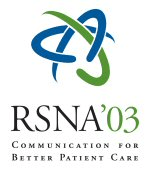
Abstract Archives of the RSNA, 2003
Nicholas Keat MS, PRESENTER: Nothing to Disclose
Abstract:
HTML
Purpose: To investigate the detectability of low contrast details on multi-slice CT scanners using a Catphan phantom. Subjective assessments of images of this phantom were made for a selection of 4 and 16 slice scanners. Variations of detectability with scan parameters and inter- and intra- viewer variability were assessed. An evaluation of the scanners' performance under standardised exposure conditions was also performed.
Methods and Materials: The low contrast section of a Catphan 550 phantom (The Phantom Laboratory, Salem, NY) was scanned under a range of exposure conditions, on multi-slice CT scanners from GE Medical Systems (LightSpeed Plus, LightSpeed 16), Philips Medical Systems (Mx8000), Siemens Medical Solutions (Sensation 4, Sensation 16) and Toshiba Medical Systems (Aquilion Multi, Aquilion 16). This phantom contains nine circular objects from 2-15 mm diameter, in a uniform background, at each of three nominal contrast levels; 0.3%, 0.5% and 1.0%. The 0.3% objects were scored for visibility, with exposure characterised by the CTDI as measured on the surface of the phantom. 20 images were assessed for each exposure condition, and when making comparisons, images were presented to the viewer in a random order.
Results: Inter- and intra-operator variability was assessed. Four observers scored 80 images for the smallest visible object in the phantom. The mean value of the standard deviation of object scores for each image was 1.1 objects. There was complete agreement between observers on the smallest visible object in only six images (7.5%). One observer scored a group of 20 images on five separate occasions, greater than a month apart. The mean value of the standard deviation for each image was 1.4 objects. There was agreement on limiting object size in none of the images. Within one image assessment session, for a single observer, the results were more consistent, with detail visibility closely following the expected trend as mAs was increased. In addition, although absolute values of detail visibility varied, general trends were apparent in the results when the same images were assessed on multiple occasions, or by multiple observers.
Conclusion: Comparison of low contrast detectability performance is made very difficult by the inherent subjectivity of the standard methods used to assess it. Meaningful comparisons are best made by viewing the images that are being compared in a single session.
Questions about this event email: nick@impactscan.org
Keat MS, N,
Low-Contrast Detail Detectability Measurements on Multi-slice CT Scanners. Radiological Society of North America 2003 Scientific Assembly and Annual Meeting, November 30 - December 5, 2003 ,Chicago IL.
http://archive.rsna.org/2003/3104671.html

